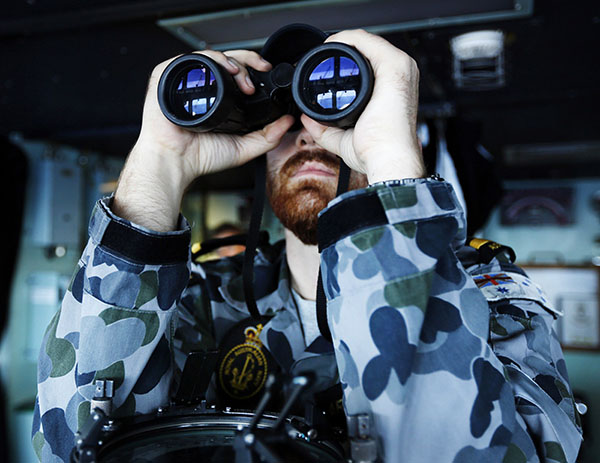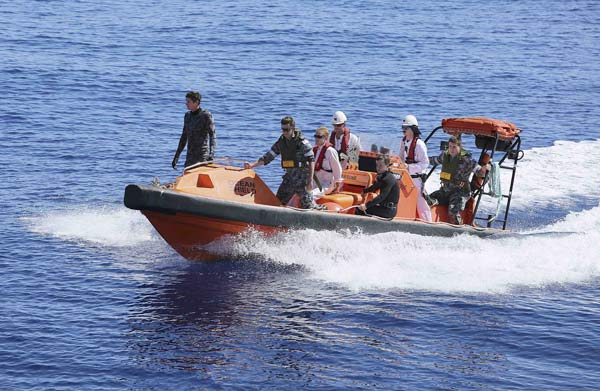| Latest News | Search effort | Families' reaction | Timeline | Reporter's log |
| Infographic | Doubts | Airlines' statement | Photos | China's perspective |
 |
|
Maritime Warfare Officer, Sub Lieutenant Officer Samuel Archibald, looks through binoculars on the bridge of the Australian Navy ship HMAS Perth in the southern Indian Ocean, during the search for the missing Malaysian Airlines flight MH370, in this picture released by the Australian Defence Force on April 8, 2014. [Photo/Agencies] |
 |
SYDNEY/PERTH, Australia?- An Australian ship which picked up possible "pings" from the black box recorders of a missing Malaysia Airlines jetliner has been unable to detect any further signals and time is running out to narrow the massive search, officials said on Tuesday.
Angus Houston, head of the Australian agency coordinating the search for Malaysia Airlines Flight MH370, said the month-long hunt in the Indian Ocean was at a critical stage given the batteries in the black box beacons had already reached the end of their 30-day expected life.
A U.S. Navy "towed pinger locator" onboard Australia's Ocean Shield picked up two "ping" signal detections over the weekend - the first for more than two hours and the second for about 13 minutes.
Houston said the signals sounded very much like black box beacons and represented the best lead in the search yet, but efforts to pick up the pings again had so far been unsuccessful.
"If we don't get any further transmissions, we have a reasonably large search area of the bottom of the ocean to prosecute and that will take a long, long time. It's very slow, painstaking work," said Houston.
The black boxes record cockpit data and may provide answers about what happened to the plane, which was carrying 239 people when it vanished on March 8 and flew thousands of kilometres off its Kuala Lumpur-to-Beijing route.
Authorities have not ruled out mechanical problems as a cause of the plane's disappearance but say evidence, including loss of communications, suggests it was deliberately diverted.
Analysis of satellite data led investigators to conclude the Boeing 777 came down in an area some 1,680 km (1,040 miles) northwest of Perth, where possible pings were picked up and the search is now focused.
Bluefin on hold
An autonomous underwater vehicle (AUV) named Bluefin-21 is onboard the Ocean Shield and could be sent to look for wreckage on the sea floor, but narrowing the search zone first was critical, Houston said.
"It is a large area for a small submersible that has a very narrow field of search, and of course, it is literally crawling along the bottom of the ocean," he said.
"That's why its so important to get another transmission and we need to continue until there's absolutely no chance the device is still transmitting."
The Bluefin will scour the ocean floor in 20-hour missions using sonar in an attempt to find the Boeing 777, before its findings are downloaded and analysed on board the Ocean Shield.
If anything unusual is spotted, the sonar on board the robotic vehicle will be replaced with a camera to take a closer look. The potential search area is about 4.5 km (2.8 miles) deep, the outer reach of the Bluefin's range.
Some 133 missions have been completed so far in the multinational aerial hunt for debris in the southern Indian Ocean but have only turned up fishing gear and other detritus.
"They go on with the same intensity that we have carried through to this point in time," Defence Minister David Johnston told reporters. "We are throwing everything at this difficult and complex task."
Up to eleven military planes, three civilian planes and 14 ships will take part in the search on Tuesday, with the Australian coordination centre reporting good weather in the search area.
|
 |
| Crew members ride a fast response craft from the Australian Defence Vessel Ocean Shield as they continue to search for debris in the southern Indian Ocean for the missing Malaysian Airlines flight MH370 in this picture released by the Australian Defence Force April 8, 2014. [Photo/Agencies] |